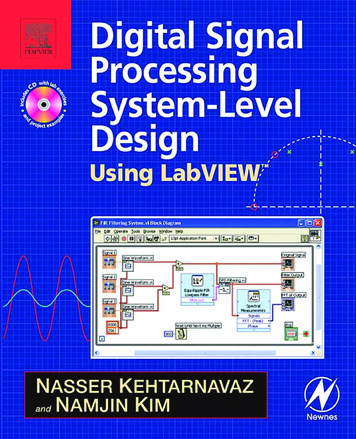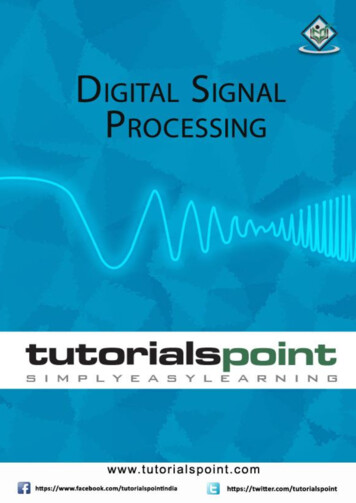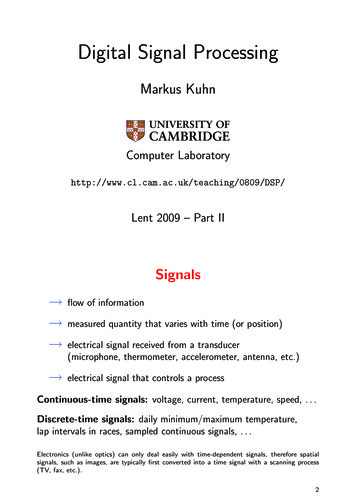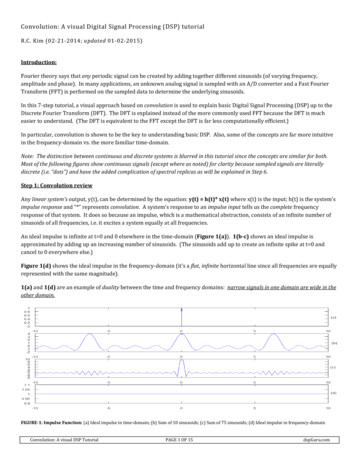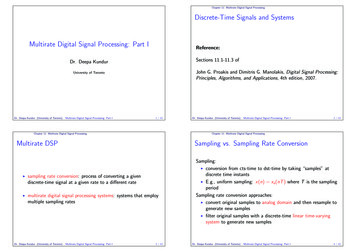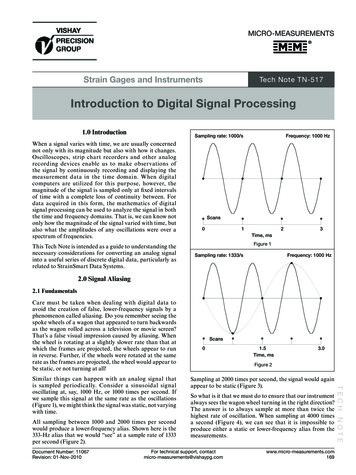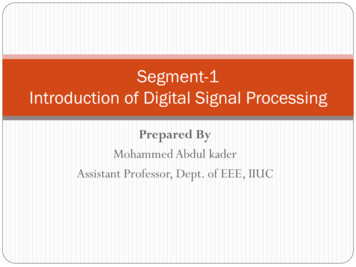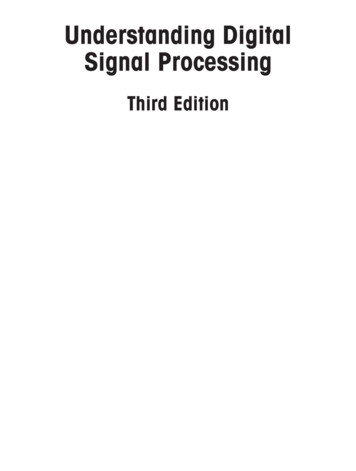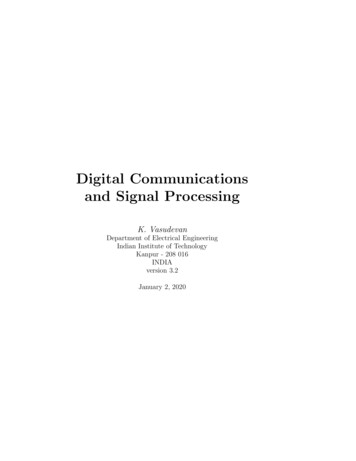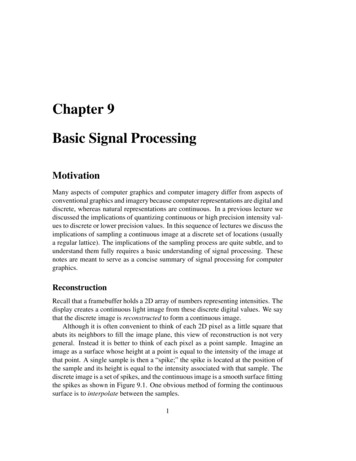
Transcription
Digital Signal Processing Using MATLABThird EditionCopyright 2010 Cengage Learning. All Rights Reserved. May not be copied, scanned, or duplicated, in whole or in part. Due to electronic rights, some third party content may be suppressed from the eBook and/or eChapter(s).Editorial review has deemed that any suppressed content does not materially affect the overall learning experience. Cengage Learning reserves the right to remove additional content at any time if subsequent rights restrictions require it.
Copyright 2010 Cengage Learning. All Rights Reserved. May not be copied, scanned, or duplicated, in whole or in part. Due to electronic rights, some third party content may be suppressed from the eBook and/or eChapter(s).Editorial review has deemed that any suppressed content does not materially affect the overall learning experience. Cengage Learning reserves the right to remove additional content at any time if subsequent rights restrictions require it.
Digital Signal Processing Using MATLABThird EditionVinay K. IngleJohn G. ProakisNortheastern UniversityAustralia Brazil Japan Korea Mexico Singapore Spain United Kingdom United StatesCopyright 2010 Cengage Learning. All Rights Reserved. May not be copied, scanned, or duplicated, in whole or in part. Due to electronic rights, some third party content may be suppressed from the eBook and/or eChapter(s).Editorial review has deemed that any suppressed content does not materially affect the overall learning experience. Cengage Learning reserves the right to remove additional content at any time if subsequent rights restrictions require it.
This is an electronic version of the print textbook. Due to electronic rights restrictions,some third party content may be suppressed. Editorial review has deemed that any suppressedcontent does not materially affect the overall learning experience. The publisher reserves the rightto remove content from this title at any time if subsequent rights restrictions require it. Forvaluable information on pricing, previous editions, changes to current editions, and alternateformats, please visit www.cengage.com/highered to search by ISBN#, author, title, or keyword formaterials in your areas of interest.Copyright 2010 Cengage Learning. All Rights Reserved. May not be copied, scanned, or duplicated, in whole or in part. Due to electronic rights, some third party content may be suppressed from the eBook and/or eChapter(s).Editorial review has deemed that any suppressed content does not materially affect the overall learning experience. Cengage Learning reserves the right to remove additional content at any time if subsequent rights restrictions require it.
Digital Signal Processing UsingMATLAB , Third EditionVinay K. Ingle and John G. ProakisPublisher, Global Engineering:Christopher M. ShorttAcquisitions Editor:Swati MeherishiAssistant Developmental Editor:Debarati RoyEditorial Assistant:Tanya AltieriTeam Assistant:Carly RizzoMarketing Manager:Lauren BetsosMedia Editor:Chris ValentineContent Project Manager: Jennifer ZieglerProduction Service: RPK Editorial ServicesCopyeditor: Fred DahlProofreader: Martha McMasterIndexer: Shelly Gerger-KnechtlCompositor: Glyph InternationalSenior Art Director:Michelle KunklerInternal Designer: Carmela PerieraCover Designer: Andrew Adamsc Marilyn Volan/ShutterstockCover Image: Rights Acquisitions Specialist:Deanna EttingerText and Image Permissions Researcher:Kristiina Paulc 2012, 2007 Cengage Learning ALL RIGHTS RESERVED. No part of this work covered by thecopyright herein may be reproduced, transmitted, stored, orused in any form or by any means graphic, electronic, ormechanical, including but not limited to photocopying,recording, scanning, digitizing, taping, web distribution,information networks, or information storage and retrievalsystems, except as permitted under Section 107 or 108 of the1976 United States Copyright Act, without the prior writtenpermission of the publisher.For product information and technology assistance, contact usat Cengage Learning Customer & Sales Support,1-800-354-9706.For permission to use material from this text or product,submit all requests online at www.cengage.com/permissions.Further permissions questions can be emailed topermissionrequest@cengage.com.Library of Congress Control Number: 2010941462ISBN-13: 978-1-111-42737-5ISBN-10: 1-111-42737-2Cengage Learning200 First Stamford Place, Suite 400Stamford, CT 06902USACengage Learning is a leading provider of customized learningsolutions with office locations around the globe, includingSingapore, the United Kingdom, Australia, Mexico, Brazil, andJapan. Locate your local office at:international.cengage.com/region.Cengage Learning products are represented in Canada byNelson Education Ltd.For your course and learning solutions, visitwww.cengage.com/engineering.Purchase any of our products at your local college store or at ourpreferred online store www.cengagebrain.com.MATLAB is a registered trademark of The MathWorks, 3 AppleHill Drive, Natick, MA.First Print Buyer:Arethea L. ThomasPrinted in the United States of America1 2 3 4 5 6 7 13 12 11 10Copyright 2010 Cengage Learning. All Rights Reserved. May not be copied, scanned, or duplicated, in whole or in part. Due to electronic rights, some third party content may be suppressed from the eBook and/or eChapter(s).Editorial review has deemed that any suppressed content does not materially affect the overall learning experience. Cengage Learning reserves the right to remove additional content at any time if subsequent rights restrictions require it.
Copyright 2010 Cengage Learning. All Rights Reserved. May not be copied, scanned, or duplicated, in whole or in part. Due to electronic rights, some third party content may be suppressed from the eBook and/or eChapter(s).Editorial review has deemed that any suppressed content does not materially affect the overall learning experience. Cengage Learning reserves the right to remove additional content at any time if subsequent rights restrictions require it.
ContentsPREFACE1xiINTRODUCTION11.1Overview of Digital Signal Processing1.2A Brief Introduction to MATLAB1.3Applications of Digital Signal Processing1.4Brief Overview of the Book2251720DISCRETE-TIME SIGNALS AND SYSTEMS2.1Discrete-time Signals2.2Discrete Systems2.3Convolution2.4Difference Equations2.5Problems222236404753vCopyright 2010 Cengage Learning. All Rights Reserved. May not be copied, scanned, or duplicated, in whole or in part. Due to electronic rights, some third party content may be suppressed from the eBook and/or eChapter(s).Editorial review has deemed that any suppressed content does not materially affect the overall learning experience. Cengage Learning reserves the right to remove additional content at any time if subsequent rights restrictions require it.
viCONTENTS3THE DISCRETE-TIME FOURIER ANALYSIS3.1The Discrete-time Fourier Transform (DTFT)3.2The Properties of the DTFT3.3The Frequency Domain Representation of LTISystems 743.4Sampling and Reconstruction of Analog Signals3.5Problems459678097THE z -TRANSFORM1034.1The Bilateral z -Transform4.2Important Properties of the z -Transform4.3Inversion of the z -Transform4.4System Representation in the z -Domain4.5Solutions of the Difference Equations4.6Problems559103107112118128134THE DISCRETE FOURIER TRANSFORM5.1The Discrete Fourier Series5.2Sampling and Reconstruction in the z -Domain5.3The Discrete Fourier Transform5.4Properties of the Discrete Fourier Transform5.5Linear Convolution Using the DFT5.6The Fast Fourier ght 2010 Cengage Learning. All Rights Reserved. May not be copied, scanned, or duplicated, in whole or in part. Due to electronic rights, some third party content may be suppressed from the eBook and/or eChapter(s).Editorial review has deemed that any suppressed content does not materially affect the overall learning experience. Cengage Learning reserves the right to remove additional content at any time if subsequent rights restrictions require it.
viiCONTENTS6IMPLEMENTATION OF DISCRETE-TIMEFILTERS 2136.1Basic Elements6.2IIR Filter Structures2156.3FIR Filter Structures2296.4Lattice Filter Structures6.5Overview of Finite-Precision Numerical Effects6.6Representation of Numbers6.7The Process of Quantization and ErrorCharacterizations 2686.8Quantization of Filter Coefficients6.9Problems7214240252275290FIR FILTER DESIGN3057.1Preliminaries7.2Properties of Linear-phase FIR Filters7.3Window Design Techniques7.4Frequency Sampling Design Techniques7.5Optimal Equiripple Design Technique7.6Problems8251306309324346360377IIR FILTER DESIGN3888.1Some Preliminaries3898.2Some Special Filter Types392Copyright 2010 Cengage Learning. All Rights Reserved. May not be copied, scanned, or duplicated, in whole or in part. Due to electronic rights, some third party content may be suppressed from the eBook and/or eChapter(s).Editorial review has deemed that any suppressed content does not materially affect the overall learning experience. Cengage Learning reserves the right to remove additional content at any time if subsequent rights restrictions require it.
viiiCONTENTS8.3Characteristics of Prototype Analog Filters8.4Analog-to-Digital Filter Transformations8.5Lowpass Filter Design Using MATLAB8.6Frequency-band Transformations8.7Problems9402425445450463SAMPLING RATE CONVERSION4769.1Introduction4779.2Decimation by a Factor D9.3Interpolation by a Factor I9.4Sampling Rate Conversion by a RationalFactor I/D 4959.5FIR Filter Designs for Sampling Rate Conversion9.6FIR Filter Structures for Sampling Rate Conversion9.7Problems10ROUND-OFF EFFECTS IN DIGITAL FILTERS47948852253210.1Analysis of A/D Quantization Noise10.2Round-off Effects in IIR Digital Filters55210.3Round-off Effects in FIR Digital Filters58010.4Problems11500540540592APPLICATIONS IN ADAPTIVE FILTERING11.1LMS Algorithm for Coefficient Adjustment11.2System Identification or System Modeling596598601Copyright 2010 Cengage Learning. All Rights Reserved. May not be copied, scanned, or duplicated, in whole or in part. Due to electronic rights, some third party content may be suppressed from the eBook and/or eChapter(s).Editorial review has deemed that any suppressed content does not materially affect the overall learning experience. Cengage Learning reserves the right to remove additional content at any time if subsequent rights restrictions require it.
ixCONTENTS11.3Suppression of Narrowband Interferencein a Wideband Signal 60211.4Adaptive Line Enhancement11.5Adaptive Channel Equalization12605605APPLICATIONS IN COMMUNICATIONS60912.1Pulse-Code Modulation12.2Differential PCM (DPCM)12.3Adaptive PCM and DPCM (ADPCM)12.4Delta Modulation (DM)12.5Linear Predictive Coding (LPC) of Speech62412.6Dual-tone Multifrequency (DTMF) Signals62812.7Binary Digital Communications12.8Spread-Spectrum 35637Copyright 2010 Cengage Learning. All Rights Reserved. May not be copied, scanned, or duplicated, in whole or in part. Due to electronic rights, some third party content may be suppressed from the eBook and/or eChapter(s).Editorial review has deemed that any suppressed content does not materially affect the overall learning experience. Cengage Learning reserves the right to remove additional content at any time if subsequent rights restrictions require it.
Copyright 2010 Cengage Learning. All Rights Reserved. May not be copied, scanned, or duplicated, in whole or in part. Due to electronic rights, some third party content may be suppressed from the eBook and/or eChapter(s).Editorial review has deemed that any suppressed content does not materially affect the overall learning experience. Cengage Learning reserves the right to remove additional content at any time if subsequent rights restrictions require it.
PrefaceFrom the beginning of the 1980s we have witnessed a revolution incomputer technology and an explosion in user-friendly applications. Thisrevolution is still continuing today with low-cost personal computersystems that rival the performance of expensive workstations. This technological prowess should be brought to bear on the educational processand, in particular, on effective teaching that can result in enhanced learning. This companion book on digital signal processing (DSP) makes asmall contribution toward reaching that goal.The teaching methods in signal processing have changed over theyears from the simple “lecture-only” format to a more integrated “lecturelaboratory” environment in which practical hands-on issues are taughtusing DSP hardware. However, for effective teaching of DSP the lecturecomponent must also make extensive use of computer-based explanations,examples, and exercises. For the past several years, the MATLAB software developed by The MathWorks, Inc. has established itself as the defacto standard for numerical computation in the signal-processing community and as a platform of choice for algorithm development. There areseveral reasons for this development, but the most important reason isthat MATLAB is available on practically all-computing platforms. In thisbook we have made an attempt at integrating MATLAB with traditionaltopics in DSP so that it can be used to explore difficult topics and solveproblems to gain insight. Many problems or design algorithms in DSPrequire considerable computation. It is for these that MATLAB providesa convenient tool so that many scenarios can be tried with ease. Such anapproach can enhance the learning process.xiCopyright 2010 Cengage Learning. All Rights Reserved. May not be copied, scanned, or duplicated, in whole or in part. Due to electronic rights, some third party content may be suppressed from the eBook and/or eChapter(s).Editorial review has deemed that any suppressed content does not materially affect the overall learning experience. Cengage Learning reserves the right to remove additional content a
Digital Signal Processing Using MATLAB , Third Edition Vinay K. Ingle and John G. Proakis Publisher, Global Engineering: Christopher M. Shortt Acquisitions Editor: Swati Meherishi Assistant Developmental Editor: Debarati Roy Editorial Assistant: Tanya Altieri Team Assistant: Carly Rizzo Marketing Manager: Lauren Betsos Media Editor: Chris Valentine
